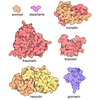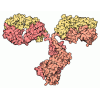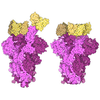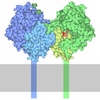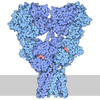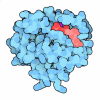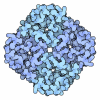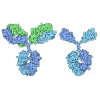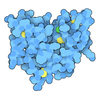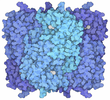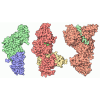[English] 日本語
 Yorodumi
Yorodumi- PDB-9nox: Transmembrane domains of the human TAS1R2 sweet receptor subunit ... -
+ Open data
Open data
- Basic information
Basic information
| Entry | Database: PDB / ID: 9nox | ||||||
|---|---|---|---|---|---|---|---|
| Title | Transmembrane domains of the human TAS1R2 sweet receptor subunit in complex with miniGs/gust25 | ||||||
 Components Components |
| ||||||
 Keywords Keywords | MEMBRANE PROTEIN / Sweet / taste / receptor / GPCR / TAS1R2 / TAS1R3 / T1R2 / T1R3 | ||||||
| Function / homology |  Function and homology information Function and homology informationsweet taste receptor complex / detection of chemical stimulus involved in sensory perception of sweet taste / sweet taste receptor activity / taste receptor activity / sensory perception of sweet taste / Class C/3 (Metabotropic glutamate/pheromone receptors) / positive regulation of cytokinesis / G protein-coupled receptor activity / Olfactory Signaling Pathway / Activation of the phototransduction cascade ...sweet taste receptor complex / detection of chemical stimulus involved in sensory perception of sweet taste / sweet taste receptor activity / taste receptor activity / sensory perception of sweet taste / Class C/3 (Metabotropic glutamate/pheromone receptors) / positive regulation of cytokinesis / G protein-coupled receptor activity / Olfactory Signaling Pathway / Activation of the phototransduction cascade / G beta:gamma signalling through PLC beta / Presynaptic function of Kainate receptors / Thromboxane signalling through TP receptor / G protein-coupled acetylcholine receptor signaling pathway / G-protein activation / Activation of G protein gated Potassium channels / Inhibition of voltage gated Ca2+ channels via Gbeta/gamma subunits / Prostacyclin signalling through prostacyclin receptor / G beta:gamma signalling through CDC42 / Glucagon signaling in metabolic regulation / G beta:gamma signalling through BTK / Synthesis, secretion, and inactivation of Glucagon-like Peptide-1 (GLP-1) / ADP signalling through P2Y purinoceptor 12 / Sensory perception of sweet, bitter, and umami (glutamate) taste / photoreceptor disc membrane / Glucagon-type ligand receptors / Adrenaline,noradrenaline inhibits insulin secretion / Vasopressin regulates renal water homeostasis via Aquaporins / G alpha (z) signalling events / Glucagon-like Peptide-1 (GLP1) regulates insulin secretion / cellular response to catecholamine stimulus / ADORA2B mediated anti-inflammatory cytokines production / ADP signalling through P2Y purinoceptor 1 / G beta:gamma signalling through PI3Kgamma / Cooperation of PDCL (PhLP1) and TRiC/CCT in G-protein beta folding / adenylate cyclase-activating dopamine receptor signaling pathway / GPER1 signaling / Inactivation, recovery and regulation of the phototransduction cascade / cellular response to prostaglandin E stimulus / G-protein beta-subunit binding / heterotrimeric G-protein complex / G alpha (12/13) signalling events / sensory perception of taste / extracellular vesicle / signaling receptor complex adaptor activity / Thrombin signalling through proteinase activated receptors (PARs) / GTPase binding / retina development in camera-type eye / Ca2+ pathway / High laminar flow shear stress activates signaling by PIEZO1 and PECAM1:CDH5:KDR in endothelial cells / fibroblast proliferation / G alpha (i) signalling events / G alpha (s) signalling events / phospholipase C-activating G protein-coupled receptor signaling pathway / G alpha (q) signalling events / Ras protein signal transduction / Extra-nuclear estrogen signaling / cell population proliferation / receptor complex / G protein-coupled receptor signaling pathway / lysosomal membrane / GTPase activity / synapse / protein-containing complex binding / signal transduction / extracellular exosome / membrane / plasma membrane / cytosol / cytoplasm Similarity search - Function | ||||||
| Biological species |  Homo sapiens (human) Homo sapiens (human) | ||||||
| Method | ELECTRON MICROSCOPY / single particle reconstruction / cryo EM / Resolution: 3 Å | ||||||
 Authors Authors | Juen, Z. / Lu, Z. / Yu, R. / Chang, A.N. / Wang, B. / Fitzpatrick, A.W.P. / Zuker, C.S. | ||||||
| Funding support |  United States, 1items United States, 1items
| ||||||
 Citation Citation |  Journal: Cell / Year: 2025 Journal: Cell / Year: 2025Title: The structure of human sweetness. Authors: Zhang Juen / Zhengyuan Lu / Ruihuan Yu / Andrew N Chang / Brian Wang / Anthony W P Fitzpatrick / Charles S Zuker /  Abstract: In humans, the detection and ultimately the perception of sweetness begin in the oral cavity, where taste receptor cells (TRCs) dedicated to sweet-sensing interact with sugars, artificial sweeteners, ...In humans, the detection and ultimately the perception of sweetness begin in the oral cavity, where taste receptor cells (TRCs) dedicated to sweet-sensing interact with sugars, artificial sweeteners, and other sweet-tasting chemicals. Human sweet TRCs express on their cell surface a sweet receptor that initiates the cascade of signaling events responsible for our strong attraction to sweet stimuli. Here, we describe the cryo-electron microscopy (cryo-EM) structure of the human sweet receptor bound to two of the most widely used artificial sweeteners-sucralose and aspartame. Our results reveal the structural basis for sweet detection, provide insights into how a single receptor mediates all our responses to such a wide range of sweet-tasting compounds, and open up unique possibilities for designing a generation of taste modulators informed by the structure of the human receptor. | ||||||
| History |
|
- Structure visualization
Structure visualization
| Structure viewer | Molecule:  Molmil Molmil Jmol/JSmol Jmol/JSmol |
|---|
- Downloads & links
Downloads & links
- Download
Download
| PDBx/mmCIF format |  9nox.cif.gz 9nox.cif.gz | 244.2 KB | Display |  PDBx/mmCIF format PDBx/mmCIF format |
|---|---|---|---|---|
| PDB format |  pdb9nox.ent.gz pdb9nox.ent.gz | 171.3 KB | Display |  PDB format PDB format |
| PDBx/mmJSON format |  9nox.json.gz 9nox.json.gz | Tree view |  PDBx/mmJSON format PDBx/mmJSON format | |
| Others |  Other downloads Other downloads |
-Validation report
| Summary document |  9nox_validation.pdf.gz 9nox_validation.pdf.gz | 1.6 MB | Display |  wwPDB validaton report wwPDB validaton report |
|---|---|---|---|---|
| Full document |  9nox_full_validation.pdf.gz 9nox_full_validation.pdf.gz | 1.6 MB | Display | |
| Data in XML |  9nox_validation.xml.gz 9nox_validation.xml.gz | 42.4 KB | Display | |
| Data in CIF |  9nox_validation.cif.gz 9nox_validation.cif.gz | 60.8 KB | Display | |
| Arichive directory |  https://data.pdbj.org/pub/pdb/validation_reports/no/9nox https://data.pdbj.org/pub/pdb/validation_reports/no/9nox ftp://data.pdbj.org/pub/pdb/validation_reports/no/9nox ftp://data.pdbj.org/pub/pdb/validation_reports/no/9nox | HTTPS FTP |
-Related structure data
| Related structure data |  49620MC 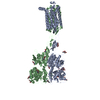 9norC 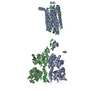 9nosC  9notC  9nouC  9novC 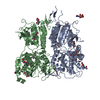 9nowC 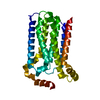 9noyC 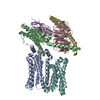 9o38C M: map data used to model this data C: citing same article ( |
|---|---|
| Similar structure data | Similarity search - Function & homology  F&H Search F&H Search |
- Links
Links
- Assembly
Assembly
| Deposited unit | 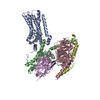
|
|---|---|
| 1 |
|
- Components
Components
| #1: Protein | Mass: 124469.336 Da / Num. of mol.: 1 Source method: isolated from a genetically manipulated source Source: (gene. exp.)  Homo sapiens (human) / Production host: Homo sapiens (human) / Production host:  Homo sapiens (human) Homo sapiens (human) |
|---|---|
| #2: Protein | Mass: 37416.930 Da / Num. of mol.: 1 Source method: isolated from a genetically manipulated source Source: (gene. exp.)  Homo sapiens (human) / Gene: GNB1 / Production host: Homo sapiens (human) / Gene: GNB1 / Production host:  Homo sapiens (human) / References: UniProt: P62873 Homo sapiens (human) / References: UniProt: P62873 |
| #3: Protein | Mass: 7861.143 Da / Num. of mol.: 1 Source method: isolated from a genetically manipulated source Source: (gene. exp.)  Homo sapiens (human) / Gene: GNG2 / Production host: Homo sapiens (human) / Gene: GNG2 / Production host:  Homo sapiens (human) / References: UniProt: P59768 Homo sapiens (human) / References: UniProt: P59768 |
| #4: Antibody | Mass: 17352.498 Da / Num. of mol.: 1 Source method: isolated from a genetically manipulated source Source: (gene. exp.)   |
| #5: Protein | Mass: 96239.008 Da / Num. of mol.: 1 Source method: isolated from a genetically manipulated source Source: (gene. exp.)  Homo sapiens (human) / Gene: TAS1R2, GPR71, T1R2, TR2 / Production host: Homo sapiens (human) / Gene: TAS1R2, GPR71, T1R2, TR2 / Production host:  Homo sapiens (human) / References: UniProt: Q8TE23 Homo sapiens (human) / References: UniProt: Q8TE23 |
| Has protein modification | Y |
-Experimental details
-Experiment
| Experiment | Method: ELECTRON MICROSCOPY |
|---|---|
| EM experiment | Aggregation state: PARTICLE / 3D reconstruction method: single particle reconstruction |
- Sample preparation
Sample preparation
| Component | Name: Transmembrane domains of the human TAS1R2 sweet receptor subunit in complex with miniGs/gust25 Type: CELL / Entity ID: all / Source: RECOMBINANT |
|---|---|
| Source (natural) | Organism:  Homo sapiens (human) Homo sapiens (human) |
| Source (recombinant) | Organism:  Homo sapiens (human) Homo sapiens (human) |
| Buffer solution | pH: 7.5 |
| Specimen | Embedding applied: NO / Shadowing applied: NO / Staining applied: NO / Vitrification applied: YES |
| Vitrification | Cryogen name: ETHANE |
- Electron microscopy imaging
Electron microscopy imaging
| Experimental equipment |  Model: Titan Krios / Image courtesy: FEI Company |
|---|---|
| Microscopy | Model: TFS KRIOS |
| Electron gun | Electron source:  FIELD EMISSION GUN / Accelerating voltage: 300 kV / Illumination mode: FLOOD BEAM FIELD EMISSION GUN / Accelerating voltage: 300 kV / Illumination mode: FLOOD BEAM |
| Electron lens | Mode: BRIGHT FIELD / Nominal defocus max: 2000 nm / Nominal defocus min: 1200 nm |
| Image recording | Electron dose: 59 e/Å2 / Film or detector model: GATAN K3 BIOQUANTUM (6k x 4k) |
- Processing
Processing
| CTF correction | Type: NONE | ||||||||||||||||||||||||
|---|---|---|---|---|---|---|---|---|---|---|---|---|---|---|---|---|---|---|---|---|---|---|---|---|---|
| 3D reconstruction | Resolution: 3 Å / Resolution method: FSC 0.143 CUT-OFF / Num. of particles: 55925 / Symmetry type: POINT | ||||||||||||||||||||||||
| Refinement | Highest resolution: 3 Å Stereochemistry target values: REAL-SPACE (WEIGHTED MAP SUM AT ATOM CENTERS) | ||||||||||||||||||||||||
| Refine LS restraints |
|
 Movie
Movie Controller
Controller




















 PDBj
PDBj